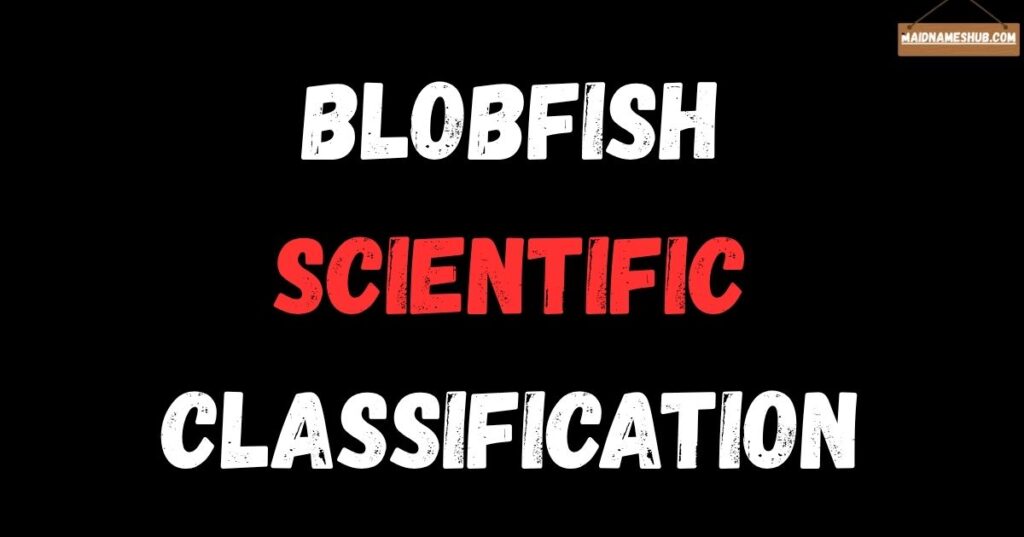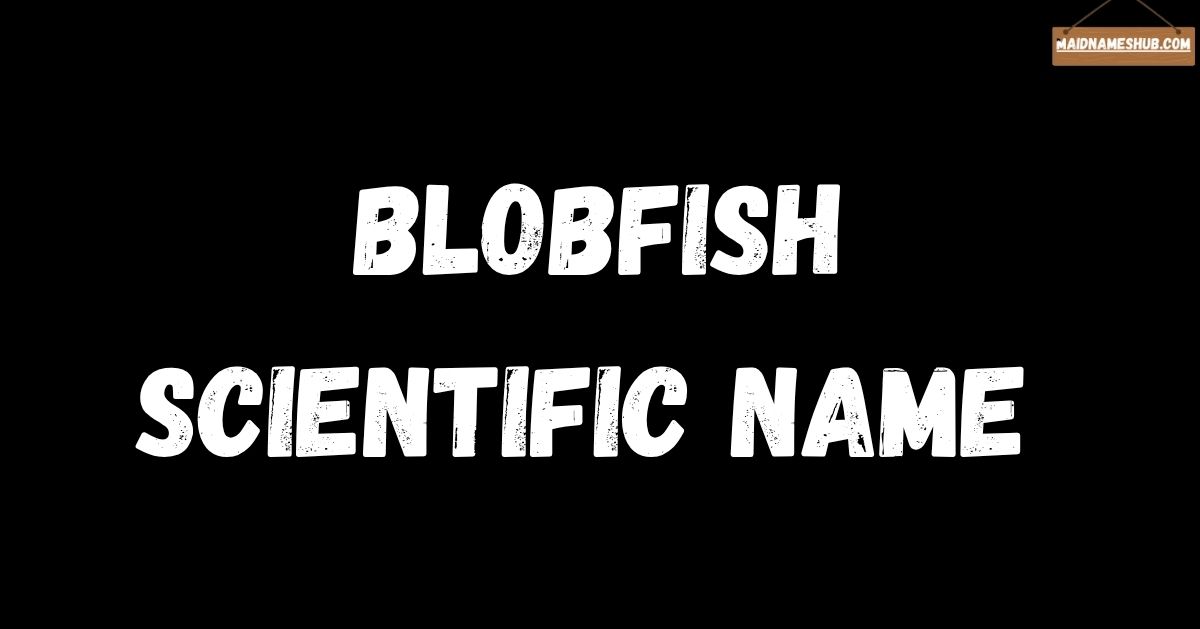The blobfish’s scientific name is Psychrolutes marcidus, a deep-sea creature famous for its strange jelly-like body and soft tissues. Found near Australia and New Zealand, this fish belongs to the Psychrolutidae family. Known as the smooth-head blobfish, it survives in extreme ocean depths where pressure is immense and light is scarce.
Many people are curious about what makes this species unique. The blobfish scientific name carries a rich story of adaptation, biology, and nature’s creativity. With a gelatinous body, minimal skeleton, and no swim bladder, the blobfish thrives in conditions where most fish cannot survive, showing true evolutionary brilliance.
Stay with us as we reveal everything about the blobfish scientific name, its genus, classification, habitat, and fascinating deep-sea secrets. You’ll also learn about its unusual diet, features, and mysterious lifestyle under crushing ocean pressure.
Meaning of the Blobfish Scientific Name
The blobfish scientific name comes from Greek and Latin roots , Psychrolutes marcidus. “Psychro” means cold, “lutes” means bath, and “marcidus” means soft. This perfectly fits its jelly-like body and deep-sea habitat. Blobfish belong to the Psychrolutidae family, with close relatives like Psychrolutes phrictus and Psychrolutes occidentalis.
- Soft Blob
- Coldwater Dweller
- Ocean Jelly
- Deep Goo
- Gelatin Ghost
- Marine Lump
- Abyss Blob
- Sea Cushion
- Goo Fish
- Deep Jelly
- Sea Pillow
- Ocean Drifter
- Blob Face
- Deep Bubble
- Fathead Fish
- Goo Spirit
- Deep Float
- Pink Blob
- Deep Diver
- Marine Pudding
- Abyss Creature
- Deep Lurker
- Jelly Monster
- Ocean Oddity
- Gooey Fish
- Squishy Blob
- Softy Sea
- Pressure Fish
- Deep Gel
- Blob Being
- Sea Lump
- Deep Jellyfish
- Ocean Cushion
- Undersea Blob
- Benthic Blob
- Deep-Sleep Fish
- Goo Soul
- Sea Wanderer
- Blob Sponge
- Abyss Dweller
- Sea Goo
- Gel Ghost
- Marine Blob
- Blob Creature
- Ocean Pillow
- Blob Beauty
- Sea Balloon
- Blob Guardian
- Underwater Blob
- Deep Pink
- Soft Ghost
- Marine Mystery
- Blob Charm
- Blob Wonder
- Blob Oddball
- Soft Blobfish
- Pressure Goo
- Abyss Wanderer
- Gel Monster
- Blob Squish
- Sea Glider
Blobfish Scientific Classification

The blobfish scientific name links directly to its biological classification. It belongs to the Kingdom Animalia, Phylum Chordata, Class Actinopterygii, Order Scorpaeniformes, and Family Psychrolutidae. Its genus Psychrolutes identifies it as a deep-sea fish adapted to cold, high-pressure habitats.
- Kingdom Animalia
- Phylum Chordata
- Class Actinopterygii
- Order Scorpaeniformes
- Family Psychrolutidae
- Genus Psychrolutes
- Species marcidus
- Deep-sea Fish
- Gelatinous Creature
- Abyss Marine
- Ocean Species
- Marine Zoology
- Blobfish Family
- Fathead Sculpin
- Psychrolutes microporos
- Psychrolutes phrictus
- Blob Sculpin
- Western Australian Sculpin
- Smooth-head Blobfish
- Marine Biology Specimen
- Gelatinous Morphology
- Soft Tissues
- Deepwater Animal
- Ocean Floor Dweller
- Benthic Organism
- Evolutionary Adaptation
- Marine Lifeform
- Cold Habitat Species
- Gel Creature
- Low Muscle Species
- High-pressure Fish
- Oceanic Adaptation
- Deep Ocean Resident
- Sea Floor Species
- Abyssal Fish
- Marine Organism
- Aquatic Animal
- Deep Creature
- Psychrolutidae Member
- Actinopterygii Fish
- Ocean Zoology
- Blobfish Lineage
- Deep-Sea Genus
- Sculpin Species
- Coldwater Organism
- Abyssal Adapted
- Ocean Floor Inhabitant
- Sea Pressure Fish
- Blob Relatives
- Deep Evolution Species
- Oceanic Creature
- Abyss Lifeform
- Blobfish Category
- Psychrolutes Group
- Deep-Sea Sculpin
- Marine Genetic Group
- Soft-bodied Animal
- Blobfish Division
- Oceanic Adapted Fish
Blobfish Conservation Status
The blobfish scientific name represents an endangered creature. While not officially listed by IUCN, scientists fear their population, estimated at around 420, is declining due to bycatch in trawlers. They face deep-sea habitat destruction, pollution, and limited food sources.
- Endangered Blob
- Threatened Blobfish
- Bycatch Victim
- Deep-sea Survivor
- Vulnerable Marine Life
- Ocean Risk Fish
- Rare Abyss Fish
- Unlisted Species
- Deep Decline
- At-risk Blob
- Marine Victim
- Conservation Concern
- Deep Endangered
- Fragile Fish
- Blob Protection
- Ocean Threatened
- Deep Loss
- Abyss Decline
- Marine Vanishing
- Rare Fish
- Blob Extinction
- Deep Danger
- Blob Rescue
- Oceanic Concern
- Marine Loss
- Pressure Victim
- Blob Saver
- Deep Hope
- Oceanic Decline
- Marine Caution
- Blob Shield
- Endangered Species
- Blob Care
- Deep-Species Concern
- Blob Awareness
- Blobfish Saving
- Oceanic Safety
- Abyssal Protection
- Deep Help
- Blobfish Focus
- Blob Life
- Sea Safety
- Marine Save
- Blob Survival
- Endangered Deep
- Abyssal Hope
- Marine Conservation
- Blob Lifeform
- Deep Shield
- Blob Protection Plan
- Marine Defender
- Blob Guardian
- Deep-sea Care
- Blobfish Concern
- Ocean Defense
- Blob Crisis
- Blob Recovery
- Deep Hope Species
- Blob Preservation
- Blob Life Save
- Marine Peace
Biological Classification of Blobfish
The blobfish scientific name Psychrolutes marcidus helps classify it as a deep-sea species with soft tissues, no swim bladder, and a gelatinous body. Belonging to the Psychrolutidae family, these fish adapt to extreme depths with slow metabolism and low energy needs.
- Psychrolutes marcidus
- Psychrolutidae Family
- Actinopterygii Class
- Deepwater Fish
- Fathead Sculpin
- Marine Species
- Ocean Dweller
- Abyss Organism
- Sea Creature
- Soft-bodied Fish
- Gelatinous Animal
- Deep Ocean Fish
- Pressure Tolerant
- Floating Species
- Benthic Creature
- Blob Evolution
- Deep-sea Adaptation
- Marine Category
- Gel Structure
- Blob Family
- Oceanic Creature
- Aquatic Organism
- Abyss Life
- Coldwater Fish
- Sea Depth Species
- Deep-Sea Taxonomy
- Blob Group
- Blob Relatives
- Deep Species
- Marine Type
- Blob Category
- Ocean Adapted
- Blobfish Order
- Blobfish Family
- Deep Marine Animal
- Abyssal Group
- Pressure Creature
- Blob Biotype
- Blob Family Group
- Oceanic Line
- Blob Division
- Blob Subtype
- Abyss Member
- Marine Strain
- Blob Organism
- Deepwater Type
- Abyssal Fish
- Ocean Family
- Blob Subgroup
- Deep Species Family
- Blob Taxonomy
- Blob Identity
- Abyss Fish Line
- Blob Marine
- Blob Biology
- Blob Subfamily
- Deep Zone Species
- Blob Marine Fish
- Abyss Group
- Blob Taxon
- Blob Category Fish
Blobfish Locations
Blobfish with the scientific name Psychrolutes marcidus live near Australia, Tasmania, and New Zealand. Some species also exist near Japan and California’s Gorda Escarpment. They live 2,000–4,000 feet deep, in cold, high-pressure, dark ocean zones.
- Australia
- Tasmania
- New Zealand
- Indian Ocean
- Pacific Ocean
- Eastern Indian Ocean
- Deep Sea
- Abyss Zone
- Benthic Zone
- Ocean Floor
- Sea Depths
- Abyssal Waters
- Japan Waters
- California
- Gorda Escarpment
- Rowley Shoals
- Southern Ocean
- Deep Pacific
- Cold Abyss
- Underwater Floor
- Marine Depth
- Ocean Layer
- Deep Habitat
- Abyss Pressure
- Marine Zone
- Ocean Cavern
- Sea Trench
- Dark Waters
- Cold Depths
- Marine Bottom
- Sea Bed
- Ocean Basin
- Deep Marine Zone
- Abyss Habitat
- Sea Floor
- Oceanic Depth
- Marine Area
- Cold Zone
- Ocean Abyss
- Sea Darkness
- Deep Cold
- Marine Surface
- Abyssal Ocean
- Undersea World
- Deep Pressure Zone
- Oceanic Trench
- Marine Floor
- Deep-sea Zone
- Ocean Depth Zone
- Deep Living Zone
- Abyss Region
- Cold Marine Zone
- Sea Layer
- Abyssal Deep
- Marine Darkness
- Blobfish Region
- Blobfish Area
- Deep Ocean Area
- Blobfish Habitat
- Blobfish Zone
Read Must : Best Nicknames for Willow: Cute, Funny, Unique & Aesthetic Ideas You’ll Adore
Genus of Blobfish: Psychrolutes
The genus Psychrolutes includes several deep-sea fish like Psychrolutes marcidus and Psychrolutes phrictus. The blobfish scientific name belongs to this group of soft, gelatinous creatures adapted for extreme pressure. These fish live in cold, low-light regions of the ocean.
- Psychrolutes marcidus
- Psychrolutes phrictus
- Psychrolutes microporos
- Psychrolutes occidentalis
- Smooth-head Blobfish
- Blob Sculpin
- Western Sculpin
- Marine Blobfish
- Deep Psychrolutes
- Blob Genus
- Fathead Fish
- Deep Sculpin
- Psychrolutidae Genus
- Blob Marine Group
- Deep-sea Genus
- Blobfish Type
- Blob Species
- Deepwater Genus
- Blob Marine Family
- Blob Group
- Psychrolutes Line
- Blob Evolution Group
- Oceanic Genus
- Marine Psychrolutes
- Blob Division
- Blob Members
- Blob Related Species
- Blob Family Genus
- Abyss Genus
- Blob Species Group
- Blobfish Psychrolutes
- Deep-sea Blob Genus
- Abyssal Blobfish
- Blobfish Branch
- Blob Genus Family
- Blob Family Member
- Psychrolutes Blobfish
- Deep Marine Psychrolutes
- Blob Relatives
- Oceanic Blob Group
- Blobfish Relatives
- Marine Blob Genus
- Blob Family Species
- Blob Marine Line
- Psychrolutes Member
- Blob Group Species
- Blob Type Family
- Blob Genus Oceanic
- Blob Genus Fish
- Blob Genus Type
- Blob Genus Member
- Blob Genus Sea
- Blob Genus Creature
- Blob Genus Line
- Blob Genus Marine
- Blob Genus Evolution
- Blob Genus Ocean
- Blob Genus Category
- Blob Genus Life
- Blob Genus Identity
Blobfish Facts
Blobfish are calm, non-aggressive deep-sea fish with gelatinous bodies. They feed on small crustaceans, mollusks, and sea pens. The blobfish scientific name marks it as a symbol of survival under crushing pressure. Mr. Blobby, found in 2003, became the world’s most famous blobfish.
- Mr. Blobby
- 2013 Ugliest Animal
- Deep-sea Resident
- Ocean Cleaner
- Passive Feeder
- Bottom Feeder
- Pink Jelly
- Gel Creature
- Deep Dweller
- Ocean Oddity
- Marine Wonder
- Deep Goo Fish
- Calm Fish
- Soft Swimmer
- Pressure Survivor
- Jelly Sea
- Deep Peace Fish
- Blob Mascot
- Australian Specimen
- Marine Star
- Abyss Celebrity
- Blob Wonder Fish
- Ocean Symbol
- Pressure Adapted
- Abyss Marvel
- Soft Species
- Jelly Survivor
- Ocean Floor Fish
- Marine Slow Fish
- Blob Hero
- Deep Icon
- Blob Star
- Marine Jelly
- Ocean Friend
- Calm Creature
- Blob Beauty
- Marine Gentle Fish
- Deep Jelly Species
- Blob Slow Swimmer
- Blob Icon Fish
- Blob Collector
- Blob Museum
- Blob Mystery
- Blob Deep Wonder
- Blob Passive Fish
- Blob Calm Sea
- Blob Character
- Blob Poster Fish
- Blob Research Fish
- Blob Study Specimen
- Blob Rare Fish
- Blob Collector’s Find
- Blob Famous Fish
- Blob Pink Icon
- Blob Science Wonder
- Blob Starfish
- Blob Ocean Fish
- Blob Curiosity
- Blob Symbolic Fish
- Blob Gentle Marine
Blobfish Pictures
Pictures of blobfish show its human-like face and squishy texture. The blobfish scientific name matches its form , Psychrolutes marcidus, a creature shaped by pressure. In natural depth, it looks like a normal fish, but on the surface, it turns jelly-like.
- Blob Portrait
- Deep Sea Photo
- Mr. Blobby Image
- Ocean Depth Photo
- Blob Texture
- Blob Smile
- Blob Headshot
- Deep Jelly Photo
- Blob Body Image
- Blob Look
- Blob Marine Photo
- Blob Goo Photo
- Blob Face Shot
- Blob Museum Photo
- Blob Head
- Blob Appearance
- Blob Deep Image
- Blob Ocean Look
- Blob Nature Photo
- Blob Natural State
- Blob Pressured Look
- Blob Pink Image
- Blob Expression
- Blob View
- Blob Fish Look
- Blob Reality
- Blob Anatomy
- Blob Picture
- Blob Original Photo
- Blob Depth Photo
- Blob Science Image
- Blob Shape
- Blob Figure
- Blob Snapshot
- Blob Closeup
- Blob Underwater Look
- Blob Still
- Blob Real Picture
- Blob Natural Form
- Blob Ocean Image
- Blob Marine Look
- Blob Natural Fish
- Blob Under Pressure
- Blob Underwater Picture
- Blob Habitat Photo
- Blob Photograph
- Blob Rare Picture
- Blob Depth View
- Blob Surface Look
- Blob Image
- Blob Appearance Photo
- Blob Profile
- Blobfish Figure
- Blob Image Shot
- Blob Photo Fish
- Blob Reality Picture
- Blob Undersea Look
- Blob Display
- Blob Capture
- Blob Displayed Image
- Blob Collection Photo
Blobfish Physical Characteristics
The blobfish scientific name represents a species with soft bones, a big mouth, no scales, and pinkish-gray color. It has low muscle mass, a flat body, and a jelly-like structure allowing survival at depths over 4,000 feet.
- Gelatinous Body
- Soft Skeleton
- Large Head
- Big Mouth
- Fleshy Lips
- No Scales
- Pink Color
- Goo Texture
- Flat Body
- Soft Flesh
- Minimal Bone
- Large Eyes
- Thick Skin
- Rounded Face
- Smooth Texture
- Soft Spine
- Gel Body
- Pressure Shape
- Gooey Look
- Flabby Body
- Light Gray Color
- Wide Mouth
- Puffy Shape
- Floating Body
- Gel Form
- Blob Structure
- Squishy Texture
- Puffy Cheeks
- Marine Gel
- No Muscle Fish
- Pressure Flesh
- Soft Layers
- Jelly Shape
- Blob Appearance
- Deep Color
- Soft Look
- Blob Face
- Blob Texture
- Blob Frame
- Soft Blob
- Marine Flesh
- Ocean Soft Body
- Blob Tissues
- Blob Organs
- Blob Fish Build
- Blob Body Type
- Blob Marine Form
- Blob Structure Look
- Blob Physical Shape
- Blob Smooth Look
- Blob Skin
- Blob Form
- Blob Fleshy Look
- Blob Outline
- Blob Marine Texture
- Blob Physical Body
- Blob Shape Look
- Blob Body Form
- Blob Physical Appearance
- Blob Marine Flesh
FAQs
What kind of fish is the blobfish?
It is a deep-sea fish known scientifically as Psychrolutes marcidus. The blobfish scientific name shows it belongs to the Psychrolutidae family, adapted to pressure.
Where does this fish live?
It lives in deep ocean zones near Australia, New Zealand, and Tasmania. The blobfish scientific name defines it as a cold-water benthic species.
What does it eat?
It eats crustaceans, mollusks, and small invertebrates. The blobfish scientific name belongs to a bottom feeder that helps clean the ocean floor.
Does the blobfish make sound?
No, blobfish cannot make sound because they lack vocal cords. The blobfish scientific name represents silent, non-vocal marine species.
Is it a mammal?
No, it is not a mammal. The blobfish scientific name shows it is a deep-sea fish species under the class Actinopterygii.
Conclusion
The blobfish scientific name Psychrolutes marcidus tells a story of a creature shaped by evolution and survival. This deep-sea animal has no swim bladder, low muscle mass, and gelatinous flesh, perfectly adapted to life in extreme pressure. It proves nature’s ability to mold life in every form imaginable.
Despite its strange look, the blobfish scientific name stands as a symbol of resilience and deep-sea mystery. It lives quietly beneath the waves, keeping balance in the marine ecosystem. This soft, calm species reminds us that beauty in nature is often hidden under pressure and patience.

